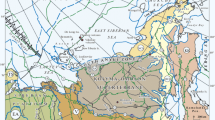Abstract
For the upper crust seismicity, the tectonic nature of earthquakes plays an important role. The allocation of zones of origin of earthquake focus (OEF zones) should be based on the tracing and typification of seismogenerating structures (SGS), the main of which are the suture zones. Dangerous for the construction, SGS zones belong to the upper seismically active layer.
Access this chapter
Tax calculation will be finalised at checkout
Purchases are for personal use only
Similar content being viewed by others
References
Nesmeyanov, S. A. (2004). Engineering geotectonics. Russia: Science 780 p.
Milanovsky, E. E. (1983). Riftogenesis in the history of the Earth (rifting on ancient platforms). Russia: Nedra 280 p.
Nesmeyanov, S. A., & Barkhatov, I. I. (1978). The newest and seismogenerating structures of the Western Gissar-Alai. Russia: Science 120 p.
Chedia, O. K. (1986). Morphostructure and the newest tectogenesis of the Tien-Shan. Russia: Ilim 314 p.
Milanovsky, E. E. (1968). The newest tectonics of the Caucasus. Russia: Nedra 484 p.
Lilienberg, D. A., Budagov, B. A., & Aliev, A. S. (1996). Morphotectonics of Azerbaijan and Eastern Transcaucasia from the standpoint of neo-mobility. Geomorphology, 4, 31–50.
Voeykova, O. A., Nesmeyanov, S. A., & Serebryakova, L. I. (2007). Neotectonics and active ruptures of Sakhalin. Russia: Science 186 p.
Nesmeyanov, S. A., Lyutikov, A. I., Voeykova, O. A., & Dontsova, G. Y. (2011). Seismicity of the northern part of Russian plate and its its glaciostatic nature. Water Resources, 38(7), 916–929.
Garetsky, R. G., Aizberg, R. E., Karabanov, A. K., et al. (1999). The newest tectonics and geodynamics of Central Europe. Geotectonics, 5, 3–14.
Yudakhin, F. N., Shchukin, Y. K., & Makarov, V. I. (2003). Deep structure and modern geodynamic processes in the lithosphere of the East European platform. Russia: UrB RAS 300 p.
Milanovsky, E. E. (1987). Geology of the USSR. Part 1. Russia: MGU 416 p.
Earthquakes and microseismicity in the tasks of modern geodynamics of the East European platform. (2007). Book. 1: Earthquakes. Russia. Petrozavodsk. KSC RAS. 391p.
Seismotectonics of plates of ancient platforms in the field of quaternary glaciations. (2009). Russia: Book and Business. 288 p.
Author information
Authors and Affiliations
Editor information
Editors and Affiliations
Rights and permissions
Copyright information
© 2019 Springer International Publishing AG, part of Springer Nature
About this chapter
Cite this chapter
Nesmeyanov, S., Voeykova, O. (2019). Suture Zones as Upper Crustal Seismogenerating Structures. In: Svalova, V. (eds) Natural Hazards and Risk Research in Russia. Innovation and Discovery in Russian Science and Engineering. Springer, Cham. https://doi.org/10.1007/978-3-319-91833-4_16
Download citation
DOI: https://doi.org/10.1007/978-3-319-91833-4_16
Published:
Publisher Name: Springer, Cham
Print ISBN: 978-3-319-91832-7
Online ISBN: 978-3-319-91833-4
eBook Packages: Earth and Environmental ScienceEarth and Environmental Science (R0)




